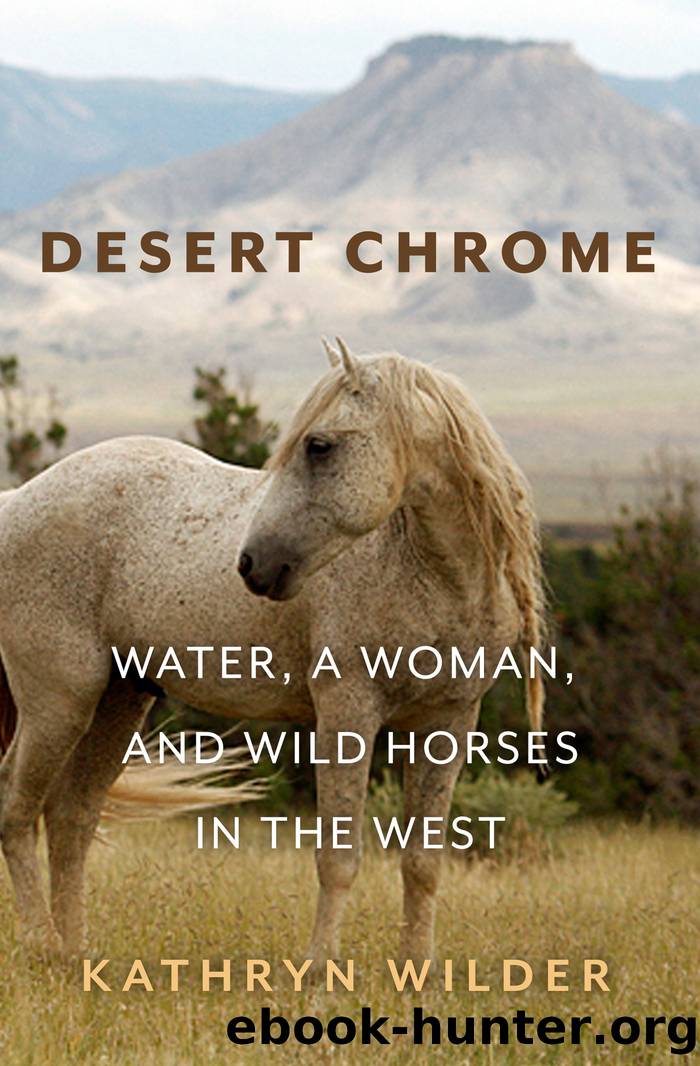Desert Chrome by Kathryn Wilder

Author:Kathryn Wilder
Language: eng
Format: epub
Publisher: Torrey House Press
Published: 2021-09-15T00:00:00+00:00
WILD HORSES PERSEVERE despite the odds. Their numbers were brutally reduced in the mid-1900s, like bison in the 1800s and Indigenous people since the first day of European contact, and when Velma Johnston of Nevada, who would come to be known as Wild Horse Annie, figured out that truckloads of mustangs were getting sold to slaughterhouses, she incited a campaign to pass into law the Wild Free-Roaming Horses and Burros Act. In December of 1971, under pressure from the publicâincluding letter-writing schoolchildrenâCongress approved the bill, which declares that âwild free-roaming horses and burros are living symbols of the historic and pioneer spirit of the West; that they contribute to the diversity of life forms within the Nation and enrich the lives of the American people; and that these horses and burros are fast disappearing from the American scene.â The law directed the Bureau of Land Management and US Forest Service to manage horses and burros found on lands within their jurisdictions, and to protect them from âcapture, branding, harassment, or death.â Today mustangs live in a spiral of high-desert lands in Montana, Wyoming, Colorado, New Mexico, Arizona, Nevada, California, Oregon, Idaho, and Utah.
Horses coevolved over millions of years with the soil, grasses, and other plant and animal species of North America. Then they disappeared from the fossil record (as far as we know to date), returning to North America with the arrival of the Spanish conquistadors in the 1500s, when they began repop-ulating those ecosystems their ancestors helped develop. Over time mesteños, the wild descendants of horses brought and left by the Spaniards, mixed with other horsesâIndian ponies, cavalry mounts, animals turned loose by farmers and ranchers in poor feed years, stallions turned loose to breed wild mares to âimproveâ the herdsâand that DNA joined the gene pools of Spanish mustang descent.
Some government agencies and individuals still contend that colonizers introduced the modern horse to North America. However, scientists like Dr. Beth Shapiro, professor of ecology and evolutionary biology at University of CaliforniaâSanta Cruz, have spent years testing DNA and paleogenomic evidence that shows that horses are indigenous to this continent.
âHorses evolved in North America,â says Dr. Shapiro. âThey are a North American species. They were a North American species for millions of years.â At the UCSC Paleogenomics Lab, research on how the horses that returned to the continent are related to the horses that left is ongoing. âThey are the same lineage of horse,â Shapiro says. When Europeans brought horses back, they were âreintroducing a native species to the North American continent.â
Dr. Ross MacPhee, curator of the Division of Vertebrate Zoology at the American Museum of Natural History, sums it up by saying, âReintroduction to North America five hundred years ago is, biologically, a non-event: horses were merely returned to part of their former native range, where they have since prospered because ecologically they never left.â
Equus caballus crossed the Bering land bridge into Siberia and back, establishing themselves on other continents; therefore, unlike mammoths and saber-toothed cats, the species did not die outâthey may have gone locally extinct, as Shapiro says, but not globally extinct.
Download
This site does not store any files on its server. We only index and link to content provided by other sites. Please contact the content providers to delete copyright contents if any and email us, we'll remove relevant links or contents immediately.
The Lonely City by Olivia Laing(4774)
Animal Frequency by Melissa Alvarez(4431)
All Creatures Great and Small by James Herriot(4277)
Walking by Henry David Thoreau(3926)
Exit West by Mohsin Hamid(3797)
Origin Story: A Big History of Everything by David Christian(3668)
COSMOS by Carl Sagan(3593)
How to Read Water: Clues and Patterns from Puddles to the Sea (Natural Navigation) by Tristan Gooley(3434)
Hedgerow by John Wright(3322)
How to Read Nature by Tristan Gooley(3295)
The Inner Life of Animals by Peter Wohlleben(3286)
How to Do Nothing by Jenny Odell(3269)
Project Animal Farm: An Accidental Journey into the Secret World of Farming and the Truth About Our Food by Sonia Faruqi(3194)
Origin Story by David Christian(3170)
Water by Ian Miller(3159)
A Forest Journey by John Perlin(3045)
The Plant Messiah by Carlos Magdalena(2903)
A Wilder Time by William E. Glassley(2838)
Forests: A Very Short Introduction by Jaboury Ghazoul(2815)
